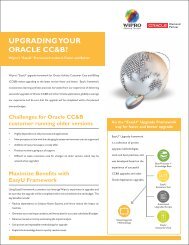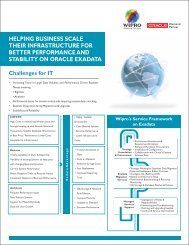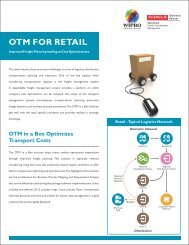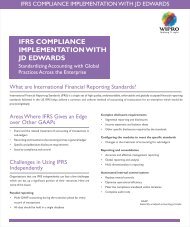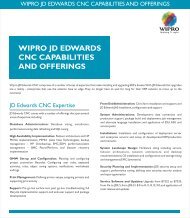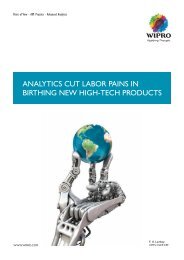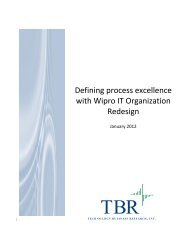GMA Unsaleables
GMA Unsaleables
GMA Unsaleables
Create successful ePaper yourself
Turn your PDF publications into a flip-book with our unique Google optimized e-Paper software.
JOINT INDUSTRY UNSALEABLES LEADERSHIP TEAM<br />
The Impact of<br />
Sales and Procurement on<br />
Reverse Logistics Management
About FMI<br />
Food Marketing Institute (FMI) conducts programs in public affairs, food safety, research, education and<br />
industry relations on behalf of its 1,500 member companies - food retailers and wholesalers - in the<br />
United States and around the world. FMI's U.S. members operate approximately 26,000 retail food<br />
stores and 14,000 pharmacies. Their combined annual sales volume of $680 billion represents threequarters<br />
of all retail food store sales in the United States. FMI's retail membership is composed of large<br />
multi-store chains, regional firms and independent supermarkets. Its international membership includes<br />
200 companies from more than 50 countries. FMI's associate members include the supplier partners of<br />
its retail and wholesale members. For more information, visit the FMI Web site at www.fmi.org<br />
About <strong>GMA</strong><br />
Based in Washington, D.C., the Grocery Manufacturers Association is the voice of more than 300<br />
leading food, beverage and consumer product companies that sustain and enhance the quality of life for<br />
hundreds of millions of people in the United States and around the globe.<br />
Founded in 1908, <strong>GMA</strong> is an active, vocal advocate for its member companies and a trusted source of<br />
information about the industry and the products consumers rely on and enjoy every day. The association<br />
and its member companies are committed to meeting the needs of consumers through product<br />
innovation, responsible business practices and effective public policy solutions developed through a<br />
genuine partnership with policymakers and<br />
other stakeholders.<br />
In keeping with its founding principles, <strong>GMA</strong> helps its members produce safe products through a strong<br />
and ongoing commitment to scientific research, testing and evaluation and to providing consumers with<br />
the products, tools and information they need to achieve a healthy diet and an active lifestyle.<br />
The food, beverage and consumer packaged goods industry in the United States generates sales of<br />
$2.1 trillion annually, employs 14 million workers and contributes $1 trillion in added value to the<br />
economy every year. For more information, visit the <strong>GMA</strong> Web site at www.gmaonline.org.<br />
About Wipro Technologies<br />
Wipro Technologies, the global IT business of Wipro Limited (NYSE:WIT) is a leading Information<br />
Technology, Consulting and Outsourcing company, that delivers solutions to enable its clients do<br />
business better. Wipro Technologies delivers winning business outcomes through its deep industry<br />
experience and a 360 degree view of “Business through Technology” – helping clients create successful<br />
and adaptive businesses. A company recognised globally for its comprehensive portfolio of services, a<br />
practitioner’s approach to delivering innovation and an organization wide commitment to sustainability,<br />
Wipro Technologies has 120,000 employees and clients across 54 countries. For more information,<br />
please visit www.wipro.com<br />
Copyright © 2010 Grocery Manufacturers Association and Wipro Technologies. All rights reserved.
1<br />
TABLE OF CONTENTS<br />
Introduction ............................................................................................ 2<br />
Objectives and Methodology ................................................................ 2<br />
<strong>Unsaleables</strong> Defined ............................................................................ 3<br />
Acknowledgements .............................................................................. 4<br />
Top Challenges ...................................................................................... 5<br />
Managing Discontinued and Expired Products ..................................... 5<br />
Managing, Capturing and Enabling ...................................................... 5<br />
Key Findings .......................................................................................... 7<br />
Finding 1 - Shelf Life Management Required ....................................... 7<br />
Finding 2 - Coordinated Planning Required ........................................ 10<br />
Finding 3 - Opportunities to Formalize Collaboration .......................... 14<br />
Finding 4 - Accountability, Incentives and Education Drive<br />
Behavior ............................................................................................. 16<br />
Finding 5 - Demand Chain Management Opportunities ...................... 19<br />
Recommendations ............................................................................... 21<br />
Bibliography ......................................................................................... 23
Introduction<br />
2<br />
INTRODUCTION<br />
Objectives and Methodology<br />
An element of unsaleables management that has come into focus in<br />
recent years is the impact of sales and procurement (internal sales,<br />
field sales organizations, sales and marketing agencies/brokers,<br />
merchandising, procurement and operations) on the volume of<br />
unsaleables. This document will reveal the findings of a study<br />
commissioned by the Joint Industry <strong>Unsaleables</strong> Leadership Team<br />
(JIULT) to better understand the effect of sales operations on<br />
unsaleables, provide recommendations to reduce the incidence of<br />
unsaleables, and raise industry awareness of future trends.<br />
The study was conducted in four phases:<br />
1. Data Collection: Development and issuance of a 28 question<br />
survey specific to JIULT manufacturer and retailer members<br />
(Table 1).<br />
2. Validation: Individual interviews with 16 subject matter experts<br />
split evenly between manufacturers and retailers.<br />
3. Analysis: In-depth analysis of the survey results, interview<br />
results, and published reports.<br />
4. Synthesize Findings: Review and summary of the findings with<br />
industry experts.<br />
Table 1 – JUILT Members<br />
Abbott Nutrition<br />
C&S Wholesale Grocers, Inc.<br />
Campbell Soup Company<br />
The Dial Corporation<br />
Energizer Holdings, Inc.<br />
General Mills, Inc<br />
Church & Dwight Company, Inc Harris Teeter, Inc.<br />
Clabber Girl Corporation H-E-B<br />
Coca-Cola North America<br />
ConAgra Foods<br />
CVS Caremark Corporation<br />
The Hershey Company<br />
H.J. Heinz Company<br />
Kraft Foods Inc.<br />
Delhaize America, Inc. Kellogg Company
3<br />
Table 1 – JUILT Members (Cont.)<br />
The Kroger Company SUPERVALU INC.<br />
Land O'Lakes, Inc.<br />
Mars Chocolate North America,<br />
LLC<br />
Nash-Finch Company<br />
Nestlé Purina PetCare Company<br />
Nestlé USA, Inc.<br />
INTRODUCTION<br />
Petco Animal Supplies, Inc.<br />
Pharmavite LLC<br />
Rite Aid Corporation<br />
Unilever<br />
Walgreen Company<br />
The Procter & Gamble Company Walmart Stores, Inc.<br />
Safeway Inc. Welch Foods, Inc.<br />
S.C. Johnson & Son, Inc.<br />
Winn-Dixie Stores, Inc.<br />
The report is organized into the following three sections:<br />
Section 1: Top Challenges: Summarizes the current challenges<br />
manufacturers and retailers are experiencing in unsaleables.<br />
Section 2: Key Findings: Outlines the current state of unsaleables<br />
and related challenges experienced by manufacturers and retailers in<br />
sales operations.<br />
Section 3: Recommendations: Provides recommendations for<br />
reducing unsaleables and resolving key challenges utilizing industry<br />
leading practices.<br />
<strong>Unsaleables</strong> Defined<br />
For purposes of this report, unsaleables are defined as consumer<br />
products which are removed from the primary channel of distribution<br />
for any reason (damaged, discontinued, or expired) and which may or<br />
may not be processed through product reclamation centers.
4<br />
INTRODUCTION<br />
Acknowledgements<br />
Wipro Technologies would like to thank <strong>GMA</strong> for providing the<br />
opportunity to develop this report for the industry. We would like to<br />
recognize the Joint Industry <strong>Unsaleables</strong> Leadership Team for their<br />
time and contributions to this effort.<br />
Co –Chair<br />
Mr. George Thrower,<br />
Manager of <strong>Unsaleables</strong><br />
Harris Teeter, Inc.<br />
Ms. Tracee Abu<br />
Manager, Customer Supply Chain<br />
The Dial Corporation<br />
Ms. Susan W. Bentel<br />
Product Supply Excellence Manager<br />
Nestlé Purina PetCare Company<br />
Mr. Bert Kibbler<br />
Associate Director, Sales<br />
Operations<br />
Kraft Foods Inc.<br />
Mr. Gary M. Piwko<br />
Director, Remarketing & Returns<br />
Management<br />
Kellogg Company<br />
Co-Chair<br />
Ms. Christine Taber<br />
Reverse Logistics Manager<br />
Church & Dwight Company, Inc.<br />
Mr. David A. Aukstikalnis<br />
Manager, Customer Logistics<br />
Welch Foods, Inc.<br />
Mr. Thomas Breiten<br />
Supply Chain Leader<br />
Energizer Holdings, Inc.<br />
Mr. Michael Mills<br />
National Returns Manager<br />
Pharmavite LLC<br />
Mr. Gary Regina<br />
Supply Chain-Replenishment,<br />
Support Manager<br />
Winn-Dixie Stores, Inc.<br />
Wipro Technologies and <strong>GMA</strong> would like to recognize the many<br />
individuals from consumer products manufacturers and retailers who<br />
supported this research by providing interviews and/or completing the<br />
survey.<br />
Finally, we extend our special thanks to <strong>GMA</strong> and FMI, specifically<br />
Logan Kastner and Patrick Walsh who provided oversight and<br />
facilitated the study.
Top Challenges<br />
“If you look at<br />
trends, most of the<br />
damages are going<br />
down – what is going<br />
up is conversion<br />
cost and expired<br />
product.”<br />
- Retailer Executive<br />
5<br />
TOP CHALLENGES<br />
Managing Discontinued and Expired Products<br />
<strong>Unsaleables</strong> continue to be a significant cost factor to both<br />
manufacturers and retailers. Study results indicate that annual<br />
average unsaleables rates, as a percent of gross sales, are .96<br />
percent for manufacturers and 1.13 percent for retailers. The potential<br />
cost impact to the study participants is over $2 billion annually. 1<br />
Expired and discontinued products represent a major challenge to<br />
manufacturers and retailers in reducing the cost of unsaleables. These<br />
two categories combine for over 50 percent of the total unsaleables<br />
incurred and have increased steadily in significance the past three<br />
years and show no signs of slowing (Figure 1).<br />
Figure 1 – <strong>Unsaleables</strong> by Type<br />
Source: Adapted from the <strong>GMA</strong>, FMI and Wipro Technologies 2010 study - The Impact of Sales and<br />
Procurement on Reverse Logistics; <strong>GMA</strong>, FMI 2003 <strong>Unsaleables</strong> Sales & Procurement Study Results; <strong>GMA</strong>,<br />
FMI and Deloitte Consulting LLP 2008 <strong>Unsaleables</strong> Study Results<br />
Though those two categories have increased, manufacturers and<br />
retailers have made noteworthy improvement in reducing the<br />
incidences of damages from 48 percent to approximately 40 percent<br />
over the past three years. 2 This is a positive indicator that focused<br />
efforts achieve results, but challenges and opportunities remain to<br />
make further impacts.<br />
Managing, Capturing and Enabling<br />
The top challenges facing manufacturers and retailers in reducing<br />
unsaleables are quite similar. In consolidating and weighting the<br />
1 Wipro Technologies, Analysis<br />
2 Deloitte Consulting, 2008 Joint Industry <strong>Unsaleables</strong> Report
6<br />
TOP CHALLENGES<br />
feedback from both parties the results indicate there are five shared<br />
challenges which impact the overall cost and process of managing<br />
unsaleables (Figure 2). These challenges are:<br />
1. Managing Open Code Dating/Expired Products<br />
– Managing the physical, financial and information flows to<br />
ensure optimal remaining shelf life and reduced volume of<br />
expired products<br />
2. Managing New Product Introductions/Discontinued Items<br />
– Coordination between manufacturers and retailers on new<br />
product launches and product discontinuations to ensure<br />
optimal sales, balanced inventory, and minimal unsaleables<br />
3. Capturing and Providing the “Right” Data<br />
– Leveraging of business capabilities by capturing relevant<br />
data and subsequently providing that information to trading<br />
partners to enable enhanced decision-making<br />
4. Enabling Effective Collaboration Internally and Externally<br />
– Establishing mutually agreed-upon objectives with defined<br />
roles and responsibilities supported by an enabling process<br />
and shared metrics<br />
5. Ensuring Proper Accountability and Incentives<br />
– Aligning accountability and incentives within crossfunctional<br />
areas to address opportunities, gain an<br />
understanding of total cost, and ensure commitment to take<br />
action to reduce unsaleables<br />
Figure 2 – Top <strong>Unsaleables</strong> Challenges<br />
Source: <strong>GMA</strong>, FMI and Wipro Technologies 2010 study - The Impact of Sales and Procurement on<br />
Reverse Logistics
Key Findings<br />
“Products are<br />
coming into the<br />
warehouse with<br />
thirty (30) days shelf<br />
life [remaining].”<br />
- Retailer Executive<br />
“[Shelf life] is an<br />
area we are looking<br />
at closely. Today we<br />
have minimum<br />
guaranteed<br />
remaining days….<br />
We are reviewing the<br />
potential of offering<br />
a minimum<br />
guarantee based on<br />
percent of<br />
manufactured code<br />
life.”<br />
- Manufacturing Executive<br />
7<br />
KEY FINDINGS<br />
Finding 1 - Shelf Life Management Required<br />
Expired and out-of-code products contribute approximately one-third to<br />
the overall cost of unsaleables resulting in an estimated $700 million in<br />
expenses for the study group. 3 For the combined industries, the<br />
financial impact is well into the billions of dollars. This does not include<br />
any potential liabilities incurred from inadvertently selling expired or<br />
out-of-code products.<br />
Reducing the proliferation of expired and out-of-code products is a<br />
priority for manufacturers and retailers; however, the solution is not an<br />
easy one as several factors contribute to the issue, including consumer<br />
confusion regarding the date or code stamped on products. In<br />
addition, neither side completely agrees as to the root cause of the<br />
problem. What is evident is that better management of product shelf<br />
life is required to reduce the amount of unsaleables. This includes<br />
education and execution in four specific areas.<br />
Remaining Shelf Life Disconnect<br />
The concern over remaining shelf life dominates the conversation<br />
between manufacturers and retailers. Manufacturers report that they<br />
are shipping products to retailers with sufficient shelf life remaining;<br />
while retailers are indicating this is not consistently occurring.<br />
Given the advances in technology, strong process manufacturing<br />
software solutions can enable companies to establish an effective<br />
product shelf life management program. Within the system,<br />
manufacturers can establish shelf life parameters by product group or<br />
category to ensure products are being shipped within agreed upon<br />
shelf life parameters. Retailers may also establish minimum shelf life<br />
requirements and reject items from being received within the actual<br />
shelf life tolerance – avoiding rejecting items in “anticipation” there will<br />
be insufficient time to sell thru. This capability should ensure, near 100<br />
percent, that no products are introduced onto the shelf without<br />
sufficient remaining life – yet it is happening.<br />
Our findings indicate that technology is not the limiting factor in<br />
connecting end-to-end shelf life between manufacturers and retailers.<br />
The disconnect resides in the material master set-up on both sides<br />
either due to process failures and/or as a result of the differences in<br />
shelf life guarantees provided by manufacturers. For example,<br />
manufacturers speak in terms of average product life given; while<br />
retailers want to know specific dates. In addition, manufacturers differ<br />
in their approach in providing shelf life guarantees either by remaining<br />
days or percent of manufactured code life.<br />
3 Wipro Technologies, Analysis
8<br />
KEY FINDINGS<br />
This is not to suggest that the manufacturer has sole responsibility, but<br />
rather to outline that better coordination and planning needs to take<br />
place to ensure product master data is synchronized and validated by<br />
both parties to ensure product shelf life is connected and managed.<br />
Product Rotation Execution<br />
In support of connecting product shelf life, retail establishments work<br />
towards maximizing shelf life by using stock rotation to move products<br />
with the earliest sell by date to the front of the shelf. This is essential<br />
to ensuring that expired and out-of-code unsaleables are reduced.<br />
Since most products contain open codes an increased level of rotation<br />
at retail stores is called for as consumers are paying attention to<br />
expiration dates, with 77 percent of consumers claiming they regularly<br />
check product code dates. 4 Given the conventional supermarket has<br />
more than 15,000 items, rotation execution at the retail level is a<br />
significant challenge. 5 The majority of retailers in our study report that<br />
proper product rotation is occurring; however, the data collected<br />
suggests room for improvement. Supporting proper product rotation is<br />
the need for customized planograms to fit fast/slow moving items with<br />
high/low volume stores. In addition, retailers should ensure policies<br />
and procedures are in place to avoid rotating items off the shelf prior to<br />
the shelf life limit being reached.<br />
Product Dating Variances<br />
The lack of standardized product date coding practices contributes to<br />
the challenges in managing the shelf life of a product in that retailers<br />
report difficulty understanding established code dates within the same<br />
product families.<br />
Manufacturers, with the adoption of open code dating, tended to be<br />
conservative in some brands in estimating the shelf life of a product<br />
thereby reducing the effective time a retailer had to potentially sell that<br />
item. For example, one brand when transitioning to open code dating<br />
reduced the shelf life from 36 to 24 months without changing the<br />
packaging or product contents. 6 Given the importance of delivering a<br />
high-quality product that has not degraded in color, texture or taste<br />
over time to brand equity, the transition to shorter shelf life could be a<br />
valid approach under open-code dating.<br />
Further contributing to product variances and potentially reducing the<br />
“real” shelf life of a product is the proliferation of accelerated product<br />
4 Insight Express, Online Survey, November 2008<br />
5 FMI, Supermarket Industry Overview, 2008 (15,000–60,000 SKU‟s)<br />
6 Wipro Technologies, Analysis
“We work internally<br />
with our Customer<br />
Service Team to<br />
identify those<br />
accounts with<br />
minimums on when<br />
they will accept short<br />
dated product.”<br />
- Manufacturing Executive<br />
9<br />
KEY FINDINGS<br />
testing. When new products are developed, manufacturers want to get<br />
them on the market as soon as possible without waiting a year for the<br />
product information needed on the packaging. Therefore, they may get<br />
data on nutrition and shelf life through the use of accelerated testing.<br />
Under this scenario the product might be subjected to greater than<br />
usual temperatures and/or humidity to simulate a year‟s time in a few<br />
months. This may result in a less than accurate quality assessment<br />
(but does not compromise food safety), impacting the final shelf life<br />
determination and reduced time for the retailer to sell the product. 7<br />
Consumer Confusion<br />
The final aspect impacting proper shelf life management is the<br />
consumer and their attitude and perception of what the product code<br />
dates really mean. Such wording as "use by, best by, best if used by"<br />
dating creates some confusion with the consumer who then<br />
determines the freshness or remaining useful life of the product<br />
independently.<br />
A new study says that 76 percent of U.S. consumers mistakenly<br />
believe certain foods are unsafe to eat after the date printed on the<br />
packaging has passed. 8 In addition, 61 percent of consumers<br />
mistakenly believe the printed date (sell-by) is the final date they can<br />
consume the product. 9 The result is a direct impact to the volume of<br />
expired and out-of-code products.<br />
Retailers prefer the sell-by date since that directly provides a reference<br />
for rotation practices and shelf management; while consumers prefer<br />
best-if-used by date. Regardless of which dates are applied, the<br />
majority of consumers are confused.<br />
To start solving this problem some companies are considering using a<br />
food label or intelligent barcode initially for meat and produce items<br />
which changes its color by reacting to ammonia given off by food as it<br />
ages. When the food is no longer edible, the food label makes the bar<br />
code unreadable and thus not available for purchase. 10<br />
7<br />
Susan Brewer, Ph.D., University of Illinois, Department of Food Science and<br />
Human Nutrition<br />
8<br />
ShelfLifeAdvice.com and Harris Interactive Study, July 2010<br />
9<br />
Sankar Sen and Lauren G. Block. "Why My Mother Never Threw Anything<br />
Out: The Effects of Product Freshness on Consumption." Journal of<br />
Consumer Research: June 2009.<br />
10<br />
Packaging of the World, Fresh Label, June 2010
10<br />
KEY FINDINGS<br />
Finding 2 - Coordinated Planning Required<br />
The findings of our research indicate that sales and procurement<br />
organizations have an opportunity to improve their joint planning<br />
processes with respect to new product launches, product<br />
discontinuations, exit strategies and execution of sales promotions to<br />
better manage and reduce unsaleables.<br />
New Product Launch<br />
New product introductions are essential to the growth of consumer<br />
products companies. Supporting those introductions a coordinated<br />
and planned process is critical to ensuring sales and margin goals are<br />
achieved and that inventory levels are appropriate to support<br />
consumer demand. In addition, coordination regarding planograms<br />
and product placement is necessary to drive sales volume.<br />
According to a 2009 survey more than 50 percent of consumer<br />
respondents cited the store shelf as their first introduction to a new<br />
product, as opposed to traditional advertising. 11<br />
As critical as new product introductions are the findings from our study<br />
indicate that 28 percent of manufacturers do not address key aspects<br />
of new product launches to ensure full retailer involvement; and 20<br />
percent do not include unsaleables benchmarks to identify new<br />
product introduction execution results (Figure 3).<br />
Figure 3 – New Product Launch Components<br />
Source: <strong>GMA</strong>, FMI and Wipro Technologies 2010 study - The Impact of Sales and Procurement<br />
on Reverse Logistics<br />
11 Nielsen, Research, 2009
11<br />
KEY FINDINGS<br />
Furthermore, manufacturer internal collaboration during launch<br />
(marketing, sales, supply chain, manufacturing, finance and<br />
procurement) does not occur in 25 percent of new product launches. 12<br />
Many retailers are structured in such way that their multiple functions<br />
(category management, procurement, store operations) do not work<br />
with each other to optimize new product launches, compounding the<br />
challenges of new product introductions.<br />
The impact to unsaleables can be substantial when a new product<br />
introduction is not properly planned between sales and procurement to<br />
ensure sufficient stock is on-hand. Five percent of new product<br />
introductions fail due to inventory shortage and availability and another<br />
11 percent fail due to an inefficient commercialization process. 13<br />
Though opportunities do exist for improvement some companies are<br />
applying leading practices to ensure new product introduction success.<br />
Some examples identified include:<br />
– Using retailer data to track new products through the supply<br />
chain, all the way to the shelf and register<br />
– Collaboration with retailers on planogram, quantities, shipment<br />
timing, retail reset support requirements, and promotional<br />
support/pricing<br />
– Working with retail buyers to review comparable launches to<br />
estimate demand and then shipment timing<br />
Discontinued Products<br />
The decision to discontinue a product is either triggered by profitability,<br />
seasonality, velocity, or new item offering decisions from the<br />
manufacturer or the retailer. The coordination of those events is<br />
essential to optimize sales and minimize unsaleables; however, our<br />
findings indicate that, for the most part, discontinued items are not<br />
managed as an integrated process. Delayed and scarce<br />
communication about discontinued products, both inside an<br />
organization as well as between trading partners, is one of the core<br />
issues driving inefficiencies.<br />
There is no consistent practice for the inclusion or exclusion of<br />
discontinued items. In some cases, discontinued products are<br />
considered unsaleables, yet in others, they are sold in markdown<br />
12 AMR Research, Innovation in Consumer Products, 2008<br />
13 Ibid
“Discontinued items<br />
are not included in<br />
our unsaleables<br />
compensation, but<br />
as we understand<br />
the industry shift …..<br />
we are proposing a<br />
more holistic<br />
approach that will<br />
ensure all players<br />
have some skin in<br />
the game.”<br />
– Manufacturing Executive<br />
12<br />
KEY FINDINGS<br />
programs and not tracked as unsaleables. Approximately 60 percent<br />
of retailers and 30 percent of manufacturers do not classify<br />
discontinued products as unsaleables (Figure 4).<br />
Figure 4 – Discontinued Products<br />
Source: <strong>GMA</strong>, FMI and Wipro Technologies 2010 study - The Impact of Sales and Procurement<br />
on Reverse Logistics<br />
This requires that each party work harder to plan ahead and ensure<br />
the approach to discontinuing items is understood and mark-down<br />
programs are effectively coordinated to limit unsaleables. What is<br />
occurring as the number of discontinued products increase is a<br />
subsequent increase in the use of markdowns to deal with this issue.<br />
Markdowns are generally charged back to the manufacturer,<br />
minimizing the profit impact to the retailer, and the typical markdown<br />
cost to the manufacturer is less than the corresponding unsaleables<br />
cost. Nevertheless, strong coordination is required to ensure<br />
discontinued items are managed efficiently to minimize unsaleables.<br />
Survey respondents indicate that they are experiencing information<br />
gaps and a fragmented process. In several examples procurement<br />
was buying items two weeks before the discontinued date resulting in<br />
excess product. Sales and broker teams were not aware the product<br />
was being discontinued; and category and marketing managers failed<br />
to inform their replenishment and purchasing departments respectively<br />
that items were being discontinued, resulting in excess product.<br />
Exit Strategies<br />
The ability to swiftly remove product from the market with minimal<br />
commercial impact and cost is essential in limiting the impact to<br />
unsaleables. While companies have been constructing their new<br />
product development skills, very few have focused on their ability to
13<br />
KEY FINDINGS<br />
successfully remove products from the market. Our findings indicate<br />
that manufacturers apply exit strategies to varying degrees dependent<br />
on the type of product (new item, seasonal, discontinued). Seventyseven<br />
percent of manufacturers confirm they use a formal exit<br />
strategy, but mostly with discontinued products. As outlined above<br />
that process is not integrated. Twenty-three percent of manufacturers<br />
do not use a formal exit strategy to remove products from the market<br />
(Figure 5).<br />
Figure 5 – Exit Strategies Used<br />
Source: <strong>GMA</strong>, FMI and Wipro Technologies 2010 study - The Impact of Sales and Procurement<br />
on Reverse Logistics<br />
Certainly new products are not introduced to fail, but not having an exit<br />
strategy is a concern given the historical failure rate is 60-80 percent,<br />
exceeding 90 percent for some categories. The reality is that the<br />
majority of new products will not succeed. Over the past 15 years less<br />
than 3 percent of new products achieved more than $50 million in oneyear<br />
sales; while 78 percent achieved less than $7.9 million in oneyear<br />
sales. 14<br />
Sales Promotions<br />
Seventy-five percent of the survey respondents reported challenges<br />
with effectively executing promotions. Failed sales promotions have<br />
become a liability to unsaleables due to open-code dating and the<br />
subsequent expiration of products. Proper sales planning and<br />
forecasting processes need to be in place to support the promotion<br />
launch and ensure product is available for consumers. Companies<br />
should also plan and forecast for the termination of the promotion to<br />
ensure inventory is in balance and that excess product is not on-hand<br />
resulting in unsaleables.<br />
14 IRI, “Innovation Highlights from 15 Years of New Product Pacesetters”,<br />
January 2010
“Some retailers are<br />
getting more<br />
sophisticated and<br />
working more<br />
closely with us to<br />
improve promotion<br />
planning. These<br />
changes have led to<br />
reduced<br />
unsaleables.”<br />
– Manufacturing Executive<br />
14<br />
KEY FINDINGS<br />
The research indicates that manufacturer sales teams and retailers still<br />
continue to operate inefficiently. Planning, communication, and<br />
collaboration are intermittent and promotions and unsaleables rates<br />
suffer. An example of what can occur when promotions are not<br />
planned appropriately is presented in (Figure 6).<br />
Figure 6 – Promotions Planning<br />
Source: Adapted from Wesley Associates Business Consultants, Inc.<br />
At the conclusion of the promotion the unsaleables rate spiked as<br />
inventory was not adjusted to account for the end of the promotion.<br />
Some manufacturers report that they lack visibility to store level<br />
promotion execution and are hindered in assisting retailers in making<br />
adjustments.<br />
Retailers report that though promotional spends can drive top-line<br />
growth, back-end costs may negate some or all of the gained benefit.<br />
Retailers report success when promotions are presented by the<br />
manufacturer, sales goals are agreed upon, and processes and<br />
supporting measures are in place.<br />
Finding 3 - Opportunities to Formalize Collaboration<br />
Formal collaboration is when participants have defined roles and<br />
responsibilities, regularly scheduled meetings take place and specific<br />
data are shared. Throughout the survey manufacturers and retailers<br />
indicated that they shared data and information or were willing to do so<br />
regularly. Examples of solid collaboration were provided and
“We have made<br />
significant<br />
reductions in<br />
unsaleables with all<br />
the suppliers we are<br />
actively involved<br />
with.”<br />
– Retailer Executive<br />
15<br />
KEY FINDINGS<br />
impressive results achieved in multiple instances in terms of reducing<br />
the overall unsaleables impact to an organization.<br />
Certainly the time is right for collaboration between manufacturers and<br />
retailers as both are experiencing the challenges associated with<br />
managing unsaleables. The sharing of data has been a key<br />
component to that effort; however, manufacturers and retailers have<br />
yet to completely formalize a collaboration process to achieve<br />
sustainable and repeatable results. 15 Thirty-nine percent of<br />
manufacturers and 17 percent of retailers report having either no<br />
collaboration or informal collaboration with their trading partners.<br />
Another 30 percent of manufacturers and 17 percent of retailers report<br />
formal collaboration with a limited number of partners (Figure 7).<br />
Figure 7 – Collaboration<br />
Source: <strong>GMA</strong>, FMI and Wipro Technologies 2010 study - The Impact of Sales and Procurement<br />
on Reverse Logistics<br />
The result of this lack of formalization is a “fire-fighting” approach to<br />
reducing unsaleables. Organizations reactively respond to a crisis<br />
rather than proactively establishing formal plans and measurements to<br />
ensure a sustainable effort and subsequent reduction in unsaleables.<br />
15 The type of shared information provided by some manufacturers includes<br />
third party audit data (suboptimal processes in the retailers‟ networks,<br />
manufacturer shortcomings, details on which SKUs/locations are outliers in<br />
terms of unsaleables rates). They also share reports on the shelf life<br />
remaining when products are shipped and review unsaleables rates by SKU<br />
and compare them to product families to help retailers make good portfolio<br />
decisions. Some retailers share point-of-sale (POS) data, inventory, and<br />
reclaim data.
16<br />
The establishment of a formal collaboration process is not<br />
reserved only for manufacturers and retailer interaction, but<br />
should also be applied internally between functional areas such<br />
as sales, merchandising, procurement and operations.<br />
Finding 4 - Accountability, Incentives and Education<br />
Drive Behavior<br />
Leading companies that align accountability and incentives to<br />
their execution processes, supported by proper education and<br />
training, are 2-3 times more likely to outperform their peers. 16<br />
Our research sought to identify which senior executive within a<br />
company was assigned “primary” accountability and<br />
responsibility for unsaleables across the organization and<br />
correlate that assignment to successful unsaleables execution<br />
and reduced costs. 17<br />
What our research indicates is that the assignment of the<br />
senior executive varies by company with manufacturers<br />
assigning unsaleables responsibility to the head of sales and<br />
marketing (38 percent) or supply chain (25 percent). The<br />
majority of retailers (56 percent) assigned unsaleables<br />
responsibility to the head of operations/supply chain (Figure 8).<br />
Figure 8 – <strong>Unsaleables</strong> Accountability<br />
Source: <strong>GMA</strong>, FMI and Wipro Technologies 2010 study - The Impact of Sales and<br />
Procurement on Reverse Logistics<br />
16 David Gordon, Strategy Execution Priority, November 2009<br />
17 “Primary” is defined as having responsibility for the financial and<br />
process aspects of unsaleables<br />
KEY FINDINGS
“Volume smoothing<br />
incentives with sales<br />
have resulted in less<br />
volume spikes”<br />
- Consumer Packaged<br />
Goods Company<br />
“Because sales reps<br />
are paid on net sales,<br />
they are paying more<br />
attention to<br />
unsaleables”<br />
- Health and Personal Care<br />
Company<br />
17<br />
The assignment level did not directly correlate to the<br />
unsaleables rate experienced by the organization or to the<br />
company‟s level of commitment in terms of improving the<br />
unsaleables process and financial impact. However, the more<br />
senior the executive the easier he/she was able to build crossfunctional<br />
alignment and bridge internal gaps and ensure<br />
external alignment.<br />
Those organizations that focus unsaleables responsibility on a<br />
shared model between sales/merchandising and supply chain<br />
incurred a smoother path to building alignment. For example, a<br />
manufacturer earlier this year transitioned its customer logistics<br />
function from reporting through sales to the supply chain<br />
organization. This served to enable a shared responsibility<br />
model and build cross-functional alignment to address<br />
opportunities to reduce unsaleables.<br />
Complimenting unsaleables accountability is the incentive<br />
structure companies provide for sales and procurement<br />
individuals to manage and limit unsaleables (Figure 9).<br />
Financial incentives in terms of a performance bonus are in<br />
place for two-thirds of organizations and all include unsaleables<br />
as part of individual performance reviews.<br />
Figure 9 – Incentives<br />
Source: <strong>GMA</strong>, FMI and Wipro Technologies 2010 study - The Impact of Sales and<br />
Procurement on Reverse Logistics<br />
However, the feedback from survey participants is that more<br />
can be done to ensure accountability and to drive results. One<br />
of the gaps cited by retailers is that the buyer/category<br />
managers may not be properly incented to reduce unsaleables.<br />
KEY FINDINGS
“We are educating<br />
our field sales reps to<br />
not over inventory<br />
retailers, and to sell-<br />
through discontinued<br />
product with<br />
markdown support.”<br />
- Food and Beverage<br />
Company<br />
“Cross-functional<br />
education is critical<br />
to the overall<br />
process of reducing<br />
unsaleables.”<br />
- Grocery Retailer<br />
18<br />
The majority of respondents indicate that procurement is not<br />
accountable for profitability at the SKU level (Figure 10). All<br />
believe that adoption of this accountability model will improve<br />
unsaleables results within the procurement organization. Those<br />
who have moved to this model have experienced success.<br />
One retailer cited lower unsaleables rates over the past two<br />
years since moving to this accountability method.<br />
Successful companies are striving to understand the total cost<br />
of unsaleables and create internal ownership opportunities and<br />
commitment to ensure action is taken to reduce unsaleables.<br />
Successful sales organizations are evolving from specific<br />
unsaleables goals to including unsaleables in the customer<br />
profitability model supported by performance metrics.<br />
Figure 10 – Procurement Accountability<br />
Source: <strong>GMA</strong>, FMI and Wipro Technologies 2010 study - The Impact of Sales and<br />
Procurement on Reverse Logistics<br />
Proper education plays an important role in managing<br />
unsaleables. Manufacturer and retail personnel from sales to<br />
procurement to merchandising need to understand the financial<br />
and brand implications of unsaleables and how their role<br />
impacts results.<br />
Our findings indicate that organizations recognize that<br />
education supports the process. Manufacturers are educating<br />
field sales representatives regarding the impact of overselling<br />
accounts and the importance of supporting discontinued SKU‟s<br />
with markdown funds. Retailers are working with procurement<br />
to outline process improvements and coordination.<br />
KEY FINDINGS
19<br />
Manufacturers and retailers indicate that they are seeing<br />
results from partner training and education commitments, but<br />
that more needs to be done to expand and cover all touch<br />
points from planogram assortments to inventory levels to<br />
information analysis.<br />
Finding 5 - Demand Chain Management Opportunities<br />
Manufacturers and retailers have an opportunity to effectively<br />
manage upstream and downstream relationships to deliver the<br />
best value and limit unsaleables exposure and assist in the<br />
management of sales and procurement interactions.<br />
Collaborative Planning, Forecasting, and Replenishment<br />
(CPFR) and Vendor Managed Inventory (VMI) potentially offer<br />
two methods to better managing interactions and the impact of<br />
unsaleables. CPFR seeks cooperative management of<br />
inventory through joint visibility and replenishment of products.<br />
Shared information between manufacturers and retailers aids in<br />
planning and satisfying consumer demands through a system<br />
of shared information. This enables continuous updating of<br />
inventory and requirements creating efficiency through the<br />
decrease of expenditures for merchandising, inventory, and<br />
logistics.<br />
Despite the potential benefits, 57 percent of retailers and 30<br />
percent of manufacturers indicated they did not have a CPFR<br />
program (Figure 11). Of those that utilize CPFR, approximately<br />
30 percent of retailers and 25 percent of manufacturers do not<br />
include Strategy and Planning or Analysis as part of their<br />
solution (Figure 12).<br />
Figure 11 – CPFR Program<br />
KEY FINDINGS<br />
Source: <strong>GMA</strong>, FMI and Wipro Technologies 2010 study - The Impact of Sales and Procurement on<br />
Reverse Logistics
“Promotions can be<br />
easily incorporated<br />
into the inventory<br />
plan by using VMI.”<br />
- Manufacturing Executive<br />
“In most cases,<br />
unsaleables have<br />
decreased by using a<br />
VMI program.”<br />
- Retailer Executive<br />
20<br />
Figure 12 – CPFR Elements<br />
Source: <strong>GMA</strong>, FMI and Wipro Technologies 2010 study - The Impact of Sales and<br />
Procurement on Reverse Logistics<br />
These are key components to ensuring success within the<br />
unsaleables arena. The purpose of Strategy and Planning is to<br />
establish the ground rules and identify significant events that<br />
affect supply and demand. The Analysis component monitors<br />
the execution, aggregates results, and shares insights for<br />
continuous improvement. The feedback from the survey<br />
respondents is that their CPFR programs are working to help<br />
manage supply and demand, but that success is predicated on<br />
the open sharing of information and taking required action<br />
without delay. It is also essential that both parties understand<br />
they have a joint responsibility for managing the overall<br />
inventory. This is where companies appear to be experiencing<br />
difficulties.<br />
VMI programs, for those adopters, are emerging to be fairly<br />
successful in reducing unsaleables rates. Sixty-seven percent<br />
of respondents indicate that they have made progress with VMI<br />
partners and that in most situations unsaleables have<br />
decreased. 18 In the rare instances where results have not been<br />
seen, retailers have stopped the process.<br />
Close to one-third of retailers indicate that VMI has not<br />
achieved desired results. The responsibility for poor<br />
performance is typically divided equally between trading<br />
partners. Effective VMI programs depend on strong<br />
relationships with information sharing, commitments, and issue<br />
18 Wipro Technologies, Analysis<br />
KEY FINDINGS
Recommendations<br />
21<br />
resolution and serve as a strong stepping stone to more<br />
productive collaborative relationships.<br />
RECOMMENDATIONS<br />
Summary Recommendations<br />
The solutions to resolving the financial impact of unsaleables are<br />
complex and multi-faceted. The five major challenges organizations<br />
experience are significant and will require continued commitment from<br />
manufacturers and retailers to affect change.<br />
1. Managing Open Code Dating/Expired Products<br />
2. Managing New Product Introductions/Discontinued Items<br />
3. Capturing and Providing the “Right” Data<br />
4. Enabling Effective Collaboration Internally and Externally<br />
5. Ensuring Proper Accountability and Incentives<br />
Organizations must collaboratively work together and strive for<br />
excellence. Based on the findings of this study and our research,<br />
below are recommended actions for improving unsaleables<br />
performance. We are not suggesting that organizations attempt to<br />
implement all at once; rather, focus on one or two key elements that<br />
enable quick wins. Achieve success and then push forward with<br />
elements that may take longer to fully implement.<br />
Shelf Life<br />
Management<br />
Coordinated<br />
Planning<br />
Synchronize Product<br />
Data<br />
Drive consistency in<br />
product shelf life<br />
Adopt targeted<br />
product rotation<br />
Consistently apply<br />
exit strategies<br />
Synchronize product data with partner to<br />
ensure product shelf life is understood<br />
Ensure a product data review process is<br />
established to account for changes in<br />
data<br />
Guarantee a reasonable amount of<br />
'minimum shelf life' to ensure sell through<br />
and collaborate with partner<br />
Explore the potential to base minimum<br />
code life on a product's sales velocity<br />
and quantities sold to the customer<br />
Identify top 10% problem SKU‟s, conduct<br />
root cause analysis and target for<br />
rotation plan or other action<br />
Ensure accuracy of planograms and<br />
customize to fit fast/slow items with<br />
high/low volume stores<br />
Reward department leads for reducing<br />
out-of-code/expired product<br />
Communicate exit strategy in writing<br />
during program sell-in and obtain<br />
agreement from the retailer buying agent<br />
Include exit strategy for any item being<br />
replaced
22<br />
Coordinated<br />
Planning<br />
(Continued)<br />
Formal<br />
Collaboration<br />
Accountability<br />
Incentives<br />
Education<br />
Demand Chain<br />
Plan Discontinued Product<br />
Coordinate New Product<br />
Launch<br />
Optimize Sales Promotions<br />
Establish a formal<br />
collaboration process<br />
Match accountability and<br />
incentive structure to<br />
desired goals and outcomes<br />
Optimize demand chain<br />
RECOMMENDATIONS<br />
Implement regular portfolio<br />
performance reviews to identify<br />
and monitor potential product<br />
delist risks or planned exits<br />
Include accountability for cost of<br />
discontinuation in new item<br />
introductions<br />
Determine product markdowns<br />
with trading partners and a<br />
establish a time limit<br />
Timely communicate decision to<br />
discontinue a product<br />
Jointly explore product<br />
redeployment options<br />
Establish clear hand-over points<br />
for each New Product Introduction<br />
(NPI) from the „project‟ team to<br />
line operations<br />
Reflect optimal store mix in<br />
distribution strategy<br />
Identify course correction<br />
opportunities throughout the<br />
product launch/checkpoints<br />
Continually monitor actual<br />
versus projected sales growth in<br />
aggregate, across consumer<br />
segments and by store<br />
Establish joint coordination for<br />
promotion execution<br />
Monitor results at specific touchpoints<br />
Assign dedicated resources<br />
Define roles & responsibilities<br />
Establish regular meetings<br />
Openly share data<br />
Assign relationship owner/leader<br />
Share cost to optimize ownership<br />
and involvement<br />
Assign SKU profitability goals and<br />
accountability metrics to<br />
procurement<br />
Assign customer profitability and<br />
metrics to sales<br />
Include strategy/planning and<br />
analysis in collaborative efforts
Bibliography<br />
23<br />
Fresh Label. Packaging of the World, June 2010.<br />
Food Dating. United States Department of Agriculture Food<br />
Safety and Inspection Service, 2009.<br />
Innovation in Consumer Products. AMR Research, 2008.<br />
“Innovation Highlights from 15 Years of New Product<br />
Pacesetters”, IRI, January 2010.<br />
Joint Industry <strong>Unsaleables</strong> Report, Deloitte, FMI and <strong>GMA</strong>,<br />
2008.<br />
New Food and Beverage Product Introductions, 2006-2009.<br />
United States Department of Agriculture Economic Research<br />
Service, 2010.<br />
Nielsen, 2009 Research.<br />
Supermarket Industry Overview. Food Marketing Institute,<br />
2008.<br />
<strong>Unsaleables</strong> Benchmark Report. FMI, <strong>GMA</strong> and Raftery<br />
Resource Network, Inc, 2005.<br />
<strong>Unsaleables</strong> Benchmark Report. FMI, <strong>GMA</strong> and Raftery<br />
Resource Network, Inc, 2006.<br />
"Why do “best by” and “use by” dates sometimes seem<br />
conservative?", ShelfLifeAdvice.com, March 2010.<br />
"Why My Mother Never Threw Anything Out: The Effects of<br />
Product Freshness on Consumption", Journal of Consumer<br />
Research, June 2009.<br />
BIBLIOGRAPHY
For more information, please contact:<br />
Nilesh Joshi<br />
CPG Industry Vertical<br />
Wipro Technologies<br />
Email: nilesh.joshi2@wipro.com<br />
Phone: +91.944.806.4076<br />
Logan Kastner<br />
Senior Manager, Industry Affairs<br />
Grocery Manufacturers Association<br />
Email: lkastner@gmaonline.org<br />
Phone: 202.639.8065<br />
David Lambert<br />
Practice Lead, CPG<br />
Wipro Technologies<br />
Email: david.lambert@wipro.com<br />
Phone: 918.688.8363<br />
Pat Walsh<br />
Senior Vice President, Industry Relations and<br />
Education/Research<br />
Food Marketing Institute<br />
Email: pwalsh@fmi.org<br />
Phone: 202.220.0703
Grocery Manufacturers Association<br />
1350 I Street, NW<br />
Suite 300, Washington, DC 20005<br />
Tel 202-639-5900, Fax 202-639-5932<br />
Copyright © 2010 Grocery Manufacturers Association and Wipro Technologies. All rights reserved.<br />
RECOMMENDATIONS<br />
Food Marketing Institute<br />
2345 I Crystal Drive<br />
Suite 800, Arlington, VA 22202<br />
Tel 202-452-8444, Fax 202-429-4519




